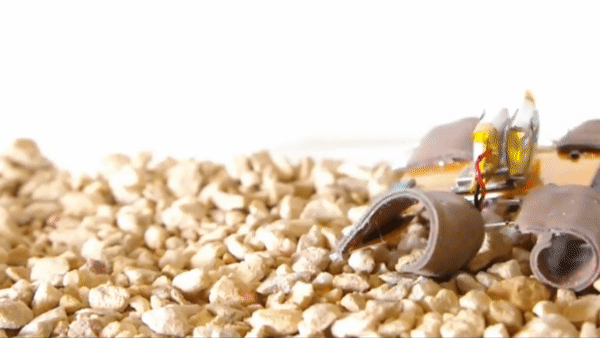Run, robot, run!
These soft robots can mimic a critter’s scurrying movements.
Observe the nimbleness of a mountain goat or the agile maneuvers of a dragonfly and you’ll recognize why roboticists look to nature’s design for inspiration.
While the seemingly-effortless movements of animals and insects hold clues to understanding dynamic locomotion, mimicking these movements in manufactured machines remains a challenge.
Robots require heavy motors, actuators, and power sources. And lots of nuts and bolts. While these rigid, cumbersome components limit the types of tasks that robots can perform, they do provide the “oomph” required to maneuver through harsh environments or withstand a crushing force.
“In robotic applications like wearable computing and human motor assistance, a softer approach is needed,” said Carmel Majidi, an associate professor of mechanical engineering at Carnegie Mellon University and a pioneer in the field of soft robotics.
Our findings can serve as a template for soft, robust robots that match the speed, dynamics, and work output of animals and motorized machines.
Carmel Majidi, Associate Professor of Mechanical Engineering, Carnegie Mellon University
In Majidi’s Soft Machines Lab, researchers investigate alternative materials and systems for compliant, flexible electronics and human-compatible machines.
Working with collaborators from the University of California, Los Angeles and the University of Nevada, Reno, the team recently published Chasing biomimetic locomotion speeds: Creating untethered soft robots with shape memory alloy actuators, in Science Robotics.
The researchers attempted to develop soft, battery operated robots that could match the locomotion of natural organisms. They combined shape memory alloy with thermally-conductive elastomer to create actuators that functioned as limbs. The natural curve of these limbs enabled the robot to carry the load of its electronics, batteries, and frame. And, because the actuators had high work density, they could generate rapid motions and forces similar to that of natural muscle.

Source: Carmel Majidi
A four-legged robot traversing a rocky surface.
One of the robots was a small, four-legged device that walked on different surfaces like poppy seeds and rocks that represented various bug-sized terrains. Another was a caterpillar-inspired robot that could traverse a 23 degree incline.
“With these untethered soft robots, we’ve demonstrated that it’s possible to reduce the size, weight, and complexity of the hardware,” said Xiaonan Huang, the lead author of the paper.
The work paves the way for future research that could, for example, explore improving the heat management of the actuators, or use novel computational tools to optimize the robots for jumping and swimming.
“Our findings can serve as a template for soft, robust robots that match the speed, dynamics, and work output of animals and motorized machines,” said Majidi.
